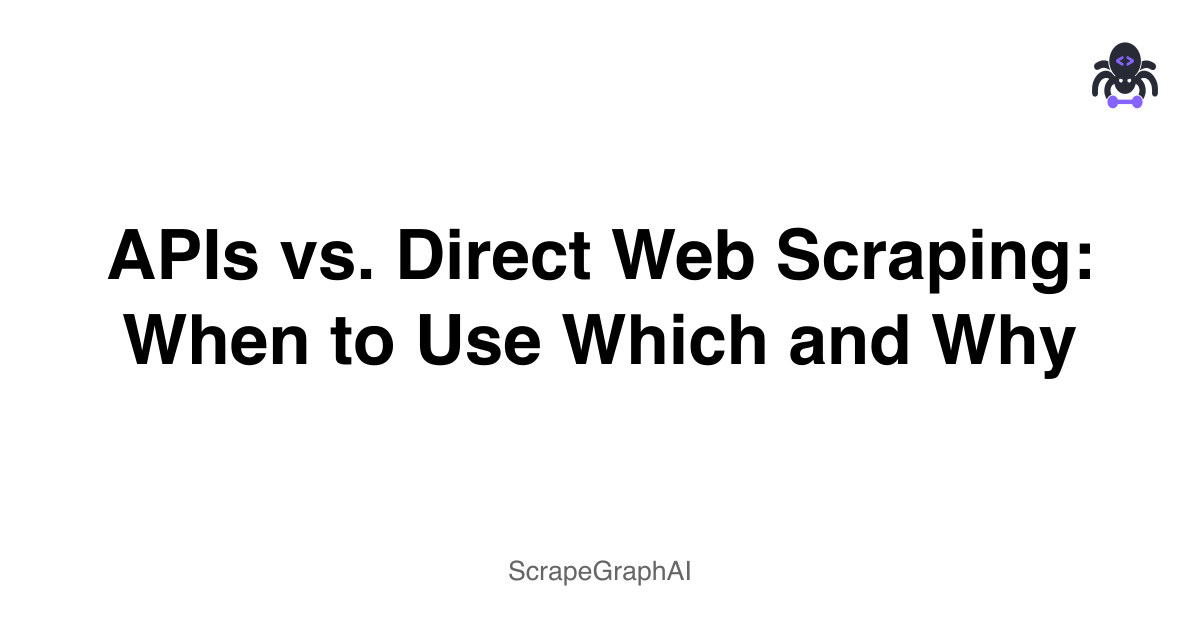In the evolving world of data extraction, teams often face a common dilemma: should we consume data via APIs or use direct web scraping? Each method has distinct advantages and tradeoffs, and choosing the right one depends on latency tolerance, data freshness needs, reliability, completeness, and maintenance overhead. This blog explores these aspects in depth and demonstrates how ScrapeGraphAI makes it easy to switch between both approaches using a consistent interface.
Understanding APIs and Web Scraping
APIs (Application Programming Interfaces) provide structured data from a source in a predefined format, often JSON or XML. They're designed for data exchange and offer well-documented, stable endpoints.
Direct Web Scraping involves extracting data from the rendered content of web pages. It's useful when no API exists or the available API lacks completeness.
Let's compare both approaches across critical dimensions.
1. Latency
- API: Typically low latency due to direct access to backend data.
- Scraping: Slightly higher latency, especially if browser rendering is required.
Use Case: For real-time pricing on thousands of SKUs, APIs are preferable. But when speed is less critical, scraping is sufficient.
2. Reliability and Rate Limits
- API: Reliable but often rate-limited (e.g., 1000 requests/day).
- Scraping: Not rate-limited but may be blocked if aggressive; requires careful throttling and headers.
Use Case: When scraping e-commerce platforms without a public API, ScrapeGraphAI uses browser simulation and dynamic headers to maintain reliability.
3. Data Completeness
- API: May omit certain fields due to privacy, policy, or versioning.
- Scraping: Can extract everything visible to users including computed prices, promotional badges, or stock status.
Use Case: A product's official API may miss discount banners or seller details, but ScrapeGraphAI can extract them directly from product pages.
4. Maintenance Overhead
- API: Low maintenance if stable; breaking changes occur during version upgrades.
- Scraping: Requires more maintenance if HTML structure changes, but ScrapeGraphAI's LLM-based logic reduces this burden.
Use Case: Instead of rewriting XPath selectors after every layout change, ScrapeGraphAI adapts using natural language prompts and schema validation.
Switching Seamlessly with ScrapeGraphAI
ScrapeGraphAI allows hybrid scraping strategies. If an API is available, it can directly parse the JSON. If not, it renders and extracts data from HTML.
Here's how to extract data from an API endpoint using ScrapeGraphAI's SmartScraperGraph:
from scrapegraphai.graphs import SmartScraperGraph
from scrapegraphai.utils import convert_to_json_schema
schema = {
"product_name": "string",
"price": "string",
"availability": "string"
}
graph = SmartScraperGraph(
prompt="Extract product name, price, and availability from the JSON API response",
source="https://api.example.com/products",
schema=convert_to_json_schema(schema),
config={
"llm": {
"provider": "openai",
"model": "gpt-4",
"api_key": "your-api-key"
}
}
)
result = graph.run()For switching to HTML scraping on product pages:
graph = SmartScraperGraph(
prompt="Extract product name, price, and availability from this product page",
source="https://www.example.com/product/123",
schema=convert_to_json_schema(schema),
config={
"llm": {
"provider": "openai",
"model": "gpt-4",
"api_key": "your-api-key"
},
"browser": {
"use_browser": True
}
}
)
result = graph.run()Real-World Comparison
Scenario 1: E-commerce Price Monitoring
| Feature | API | Scraping |
|---|---|---|
| Price | Available, sometimes outdated | Real-time, includes discounts |
| Product Availability | Sometimes delayed | Accurate if extracted from UI |
| Seller Details | Often missing | Fully visible on product page |
Using ScrapeGraphAI, you can extract both and cross-validate accuracy.
Scenario 2: Job Postings Aggregation
| Feature | API (LinkedIn, Indeed) | Scraping Job Boards |
|---|---|---|
| Quotas | Strict (e.g., LinkedIn limits per app) | None, but needs good crawler hygiene |
| Field Richness | Basic title, company, location | Includes salary, benefits, job tags |
ScrapeGraphAI enables scraping with schema validation, allowing structured export for dashboards or analytics.
Performance Metrics: Before and After
Test: Monitoring 100 product pages hourly
| Metric | Traditional Scraper | ScrapeGraphAI |
|---|---|---|
| Failure Rate | 12% (due to layout changes) | <2% (LLM adaptability) |
| Schema Accuracy | Manual validation needed | Auto-validated schema |
| Avg. Setup Time/Page | 15 mins | <2 mins |
ScrapeGraphAI reduces dev time, boosts resilience, and unifies scraping across APIs and HTML.
FAQs
Can ScrapeGraphAI fallback to scraping if an API fails?
Yes. You can implement fallback logic where the primary source is an API, and if that returns null or errors, it will switch to scraping.
What about authentication headers?
You can pass custom headers, tokens, or cookies into the source configuration for both API and browser-based scraping.
Is scraping slower than APIs?
Slightly, but for most research and ETL workflows, this difference is negligible—especially when batching and caching are applied.
Can I scrape APIs with pagination?
Yes. ScrapeGraphAI supports looping through paginated URLs and can parse paginated JSON results via schema definitions.
Conclusion
There's no universal best between APIs and direct scraping—it depends on your goals. APIs provide speed and stability, but scraping offers flexibility and completeness. With ScrapeGraphAI, you get the best of both worlds: a schema-first, LLM-powered system that adapts to APIs or web pages using the same Python interface.
Whether you're monitoring prices, extracting datasets, or enriching research with public data, ScrapeGraphAI helps you work smarter, not harder.
Related Resources
Want to learn more about social media data extraction and lead generation? Explore these guides:
- Web Scraping 101 - Master the basics of data extraction
- AI Agent Web Scraping - Learn about AI-powered lead generation
- Mastering ScrapeGraphAI - Deep dive into scraping capabilities
- Facebook Smart Scraper - Learn about social media scraping
- Structured Output - Master data formatting
- Browser Automation vs Graph Scraping - Compare different scraping approaches
- Web Scraping Legality - Understand legal considerations
- Data Innovation - Discover new lead generation techniques
